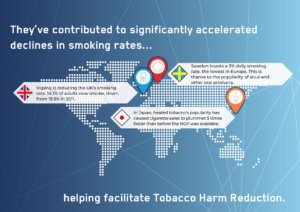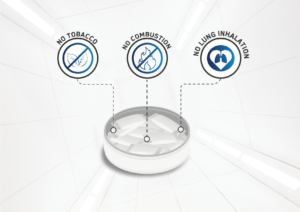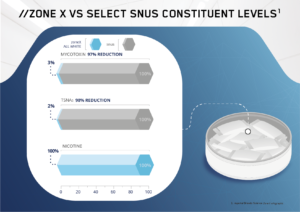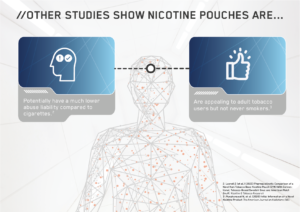//Commentary: the tobacco-free nicotine pouch opportunity
Posted 12/10/2020 10:41am
Are tobacco-free oral nicotine pouches the Next Big Thing in tobacco harm reduction? Thomas Nahde, Scientific and Regulatory Affairs (DACH and Nordics), examines the facts.
Tobacco harm reduction (THR) represents one of the most promising global public health policies: to encourage adult smokers who would otherwise continue to smoke to transition to less harmful products that deliver nicotine, but with fewer and substantially lower levels of toxicants associated with burning tobacco. THR is simple, compelling and has the potential to save many lives if fully embraced.
Smoking tobacco is the most harmful way for adults to consume nicotine. Yet science has long demonstrated that although adult smokers smoke for nicotine, it is not a known carcinogen nor the primary cause of smoking-related diseases. The highest risk of smoking-related diseases comes from burning tobacco and inhaling the smoke, which contains numerous toxicants that cause or could cause harm to smokers and non-smokers1.
Recent advances in technology have created a completely new range of innovative alternative nicotine products that have the potential to be significantly less harmful for adult smokers. The most recent tobacco harm reduction innovation is tobacco-free oral nicotine pouches. Because they are not combusted and contain no tobacco leaf, they have the potential to be the least harmful of all currently available consumer (non-medicinal) nicotine products.
Tapping potential
Society has been aware of the health risks posed by smoking tobacco for decades, yet over one billion adults worldwide continue to smoke2. The best action adult smokers can take to improve their health is complete cessation of all tobacco and nicotine use. However, millions are either uninterested – or unwilling – to take this step, despite public health campaigns, numerous deterrent behavioural mechanisms and legislative instruments.
With this in mind, proactively transitioning adult smokers to less harmful nicotine-containing products can be the next best option. Central to tobacco harm reduction is a recognition that not all nicotine-containing products are as equally harmful as smoked tobacco, and that alternative nicotine products (such as heated tobacco, Scandinavian snus, high quality chewing tobacco, modern snus, tobacco-free oral nicotine pouches and e-vapour products) are legitimate and much less harmful tools that help to reduce smoking-related morbidity and mortality3.

Next Generation Products such as Snus have contributed to declining smoking rates in many countries.
Moreover, there is a growing recognition that nicotine – whilst an addictive substance – can be delivered through products across a spectrum of risk. Evidence suggests that countries who have invested in understanding and communicating the science and potential of alternative nicotine products have experienced accelerated declines in smoking rates in comparison to countries who have not. For example, the availability, public health advocacy and ensuing popularity of e-vapour in the UK4, heated tobacco in Japan5, and tobacco snus in Sweden6 have all played a major role in accelerating declines in smoking prevalence to the lowest rates on record.
Importantly, randomised controlled clinical trials, observational studies and population data suggests these products are more satisfying – and acceptable – to adult smokers than traditional nicotine replacement products (NRTs) like patches, lozenges, and gums,7,8. In addition, long-term smoking abstinence using NRTs is reportedly very low, and relapse rates high. This highlights the current and urgent unmet needs of millions of adult smokers seeking satisfying and potentially less harmful alternatives to smoking tobacco and new and innovative nicotine products may be in a good position to meet these demands.
Research highlights
Tobacco-free nicotine pouches are one of the most recent product innovations available in a growing number of countries. Unlike traditional tobacco-containing Scandinavian snus – and even though they share the same oral method of use – they are completely free of tobacco leaf. Typically, these small pouches contain high purity pharmaceutical grade nicotine in dry powder format or with a plant fibre-based substrate, and other high-quality ingredients including flavourings, humectants to retain moisture, and additives to ensure product stability (See image below).
Pouches are placed under consumers’ lips against the gums for up to 30 minutes, steadily releasing nicotine which is efficiently absorbed into the bloodstream through the oral mucosa. This way of consuming nicotine is in complete contrast with smoking tobacco, and the inhalation of heated tobacco and e-vapour aerosols, where nicotine is absorbed through the airways and lungs.

Nicotine pouches do not require tobacco, combustion, or lung inhalation.
Nicotine pouches contain no tobacco leaf and don’t require combustion, so it is expected that levels of notable toxicants of public health interest such as tobacco-specific nitrosamines (TSNAs), polycyclic aromatic hydrocarbons (PAHs) and carbon monoxide will be substantially lower compared to tobacco smoke and other reduced harm nicotine products – if at all present at detectable levels.
Studies characterising nicotine pouches are now beginning to appear in the scientific literature. A 2020 single dose pharmacokinetics clinical study assessing a new nicotine pouch product demonstrated efficient extraction of nicotine from the oral cavity and its uptake into the systemic blood circulation via the oral mucosa, with no significant adverse effects reported9. The study demonstrated clearly that nicotine from such products is orally absorbed – not swallowed – because first-pass elimination coupled with low stomach pH would result in only limited blood nicotine delivery and a considerably different pharmacokinetic profile. (See also this study from swallowed nicotine gums that show appearance of nicotine much later (three hours) in the blood, and this newer review.)
The associated nicotine pharmacokinetic parameters for the nicotine pouch showed a maximum nicotine concentration comparable to smoking a cigarette, but with a time to maximum concentration that was longer and consistent with oral mucosal nicotine absorption. The total extent of nicotine exposure was also substantially less compared to typical cigarette smoking. This pharmacokinetic profile of nicotine delivery, which does not exceed that of cigarettes, indicates nicotine pouches potentially have a much lower abuse liability compared to cigarettes, especially given the absence of usual behavioural cues associated with combustible tobacco.

Tobacco free pouches like ZoneX contain fewer contaminants than tobacco-containing Snus.
In the first published scientific assessment of a nicotine pouch product, consumer panel data showed adult tobacco users not only found such products moderately to extremely appealing but also by far were the largest group of regular users10. The most popular reason given for using nicotine pouches was for harm reduction and health reasons. Importantly, both never smokers and long-term ex-tobacco users indicated much less interest in the product – and even less interest in purchasing – with very few never tobacco users (<4%) engaged in current use.
However, it is important to note that the absence of inhalation, which is associated with the behavioural and sensorial aspects of the smoking experience, may make it more difficult initially for adult smokers to transition to nicotine pouches due to the lack of familiar rituals and sensorial cues. Each individual adult smoker is unique so their journey to becoming smoke-free can be significantly aided and maximised by access to a broad range of different and harm reduction options fit for individual purpose.
Pouch roadmap
The relative nascency of many products is reflected in the state of their accompanying published science. This is particularly applicable to tobacco-free nicotine pouches, where there are clearly current and future research gaps that need to be addressed.
Whereas the few published studies have considered tobacco snus as a comparator product, the maximum public health benefit that nicotine pouches offer is likely to be derived from understanding these products compared to smoking tobacco and the potential benefits for adult smokers who transition to them. Therefore, a focus for future studies should be the thorough risk characterisation of these products as an alternative to combustible tobacco for current adult smokers.

More research needs to be conducted on tobacco-free oral nicotine products.
Equally critical, is an understanding that nicotine pouches are not used by nicotine naïve consumers, which may diminish their population-level harm reduction potential.
Though improvements in technology and continued innovation, the private sector is developing a diverse range of less harmful nicotine products. In countries where reduced harm products have broadly been advocated by regulators and public health bodies, they have already had a positive public health impact and contributed to significantly accelerated declines in smoking rates.
Nicotine pouches offer another unprecedented opportunity to help facilitate tobacco harm reduction for the world’s one billion adult smokers. We believe further scientific research and public health advocacy of these products is fully warranted.
—
You are free to share this content with credit to Imperial Brands under a Attribution-NoDerivatives 4.0 International (CC BY-ND 4.0) license.

- Food and Drug Administration. Harmful and Potentially Harmful Constituents in Tobacco Products and Tobacco Smoke; Established List. Federal Register 2012. https://www.fda.gov/tobacco-products/rules-regulations-and-guidance/harmful-and-potentially-harmful-constituents-tobacco-products-and-tobacco-smoke-established-list
- World Health Organisation (WHO). Tobacco: Key Facts 2020. Accessed 05 August 2020. https://www.who.int/news-room/fact-sheets/detail/tobacco
- O’Leary R, Polosa R. Tobacco harm reduction in the 21st century. Drugs and Alcohol Today. 2020; (ahead-of-print). https://www.emerald.com/insight/content/doi/10.1108/DAT-02-2020-0007/full/html
- McNeill A, Brose LS, Calder R, Bauld L, Robson D. Evidence review of e-cigarettes and heated tobacco products 2018. A report commissioned by Public Health England. https://www.gov.uk/government/publications/e-cigarettes-and-heated-tobacco-products-evidence-review
- Cummings KM, Nahhas GJ, Sweanor DT. What Is Accounting for the Rapid Decline in Cigarette Sales in Japan? International journal of environmental research and public health. 2020;17(10):3570. https://www.mdpi.com/1660-4601/17/10/3570
- Clarke E, Thompson K, Weaver S, Thompson J, O’Connell G. Snus: a compelling harm reduction alternative to cigarettes. Harm Reduction Journal. 2019;16(1):62. https://harmreductionjournal.biomedcentral.com/articles/10.1186/s12954-019-0335-1
- Royal College of Physicians. Harm reduction in nicotine addiction: Helping people who can’t quit. London: Royal College of Physicians, 2007. https://shop.rcplondon.ac.uk/products/harm-reduction-in-nicotine-addiction-helping-people-who-cant-quit
- Royal College of Physicians. Nicotine without smoke—tobacco harm reduction. London: Royal College of Physicians, 2016. https://www.rcplondon.ac.uk/projects/outputs/nicotine-without-smoke-tobacco-harm-reduction
- Lunell E, Fagerström K, Hughes J, Pendrill R. Pharmacokinetic Comparison of a Novel Non-tobacco-Based Nicotine Pouch (ZYN) With Conventional, Tobacco-Based Swedish Snus and American Moist Snuff. Nicotine & Tobacco Research. 2020. https://pubmed.ncbi.nlm.nih.gov/32319528/
-
Plurphanswat N, Hughes JR, Fagerström K, Rodu B. Initial Information on a Novel Nicotine Product. The American Journal on Addictions. 2020. https://onlinelibrary.wiley.com/doi/abs/10.1111/ajad.13020
